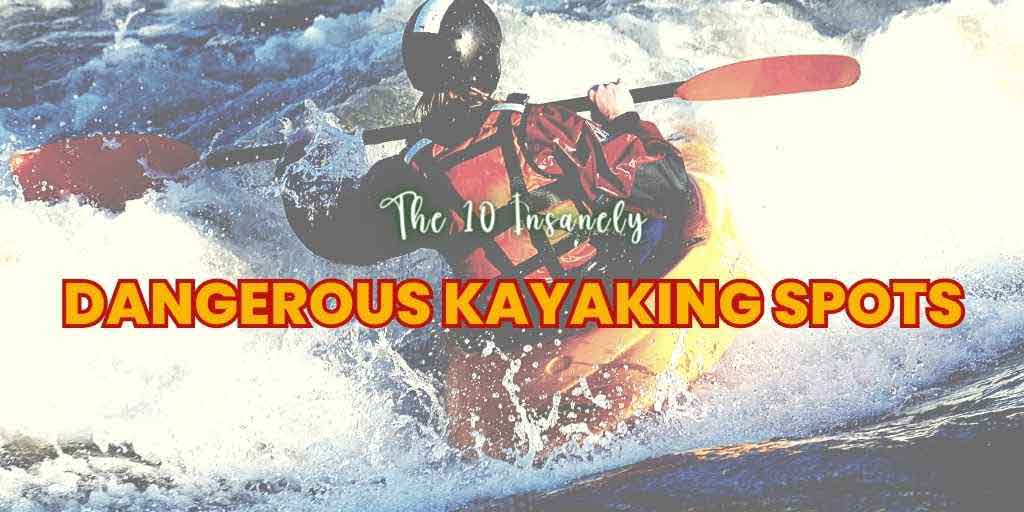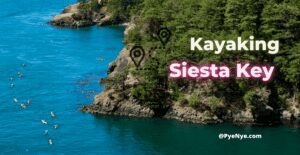Kayaking can be a thrilling and exhilarating sport, but for some, the thrill is not enough. Extreme kayaking takes the excitement to another level as daredevils seek out the most dangerous and challenging rapids and waterways in the world. But with great risks come great dangers, and only the most experienced and skilled kayakers should attempt these treacherous routes.
In this article, we will explore 10 of the most insanely dangerous kayaking spots for extreme kayakers. Our goal is not to encourage anyone to attempt these routes but rather to highlight the extreme risks involved and emphasize the importance of safety and experience in extreme kayaking.
Let’s start with the importance of safety and experience for kayaking in such dangerous spots;

Jump To A Section
The 10 Insanely Dangerous Kayaking Spots In The World
For thrill-seekers looking for the ultimate adrenaline rush, there are some kayaking spots that are not for the faint of heart. From raging whitewater rapids to treacherous sea caves, these 10 insanely dangerous kayaking spots will test even the most experienced paddlers’ skills and bravery.
Listing these 10 insanely dangerous kayaking spots;
- White Nile, Uganda
- North Fork Payette River, Idaho, USA
- Rio Upano, Ecuador
- Tsangpo Gorge, Tibet
- Futaleufú River, Chile
- Rio Santo Domingo, Venezuela
- Verzasca River, Switzerland
- Stikine River, British Columbia, Canada
- Zambezi River, Zimbabwe
- The Grand Canyon, Arizona, USA
So, buckle up, and let’s explore the most challenging and treacherous kayaking spots in the world.
White Nile, Uganda
White Nile is known for its challenging whitewater rapids, which range from Class III to Class VI. The river is especially treacherous during the rainy seasons when high water levels can create powerful and unpredictable rapids. Additionally, the river is known to be home to crocodiles and hippos, which pose a threat to kayakers if they come too close. It is highly recommended that kayakers have experience and take necessary safety precautions when kayaking on the White Nile in Uganda.
The region also experiences two rainy seasons, with the heaviest rains occurring between March and May and a shorter rainy season between October and December. During these periods, the water levels in the river can rise significantly, and strong currents and rapids can form, increasing the difficulty and danger of kayaking.
| Factors | White Nile, Uganda |
| Classification of rapids | Class II to Class V+ |
| Length of river | 2300 miles |
| Water temperature | Mild, ranging from 68-86°F Avg. |
| Weather conditions | Tropical climate |
| Hazards | Unpredictable rapids, Strong Currents |
The river’s strong and unpredictable rapids require expert-level kayaking skills and experience, and even experienced kayakers can be at risk of injury or drowning if they make a mistake or underestimate the power of the river. Additionally, the White Nile is known for its strong currents, unpredictable water levels, and hidden underwater hazards, all of which can make kayaking even more dangerous.
Despite these risks, many experienced kayakers flock to the White Nile every year to test their skills and push themselves to their limits.
North Fork Payette River, Idaho, USA
The North Fork of the Payette River in Idaho, USA, is widely regarded as one of the most dangerous kayaking destinations in the world. This river is known for its extremely steep gradient, which results in powerful, continuous rapids that require advanced-level kayaking skills and experience to navigate safely.
The river itself is known for its challenging whitewater rapids, with class III to class V rapids that require advanced paddling skills and experience. Hazards on the river include undercut rocks, log jams, and fast currents, which can make rescues difficult.
During the summer months, when water levels are lower, the water temperature can range from the mid-50s to the low 60s Fahrenheit. While the average low temperature in winter ranges from the teens to low-20s Fahrenheit (-7 to -5°C).
However, sudden thunderstorms and heavy rain can occur, causing flash floods and rapidly changing water levels.
| Factors | North Fork Payette River, Idaho, USA |
| Classification of rapids | Class III to Class V |
| Length of river | 113 miles |
| Water temperature | Mild, ranging from 40-60°F Avg. |
| Weather conditions | Typically Cold |
| Hazards | Log jams undercut rocks, fast currents |
In 2017, a kayaker lost their life after becoming trapped in a hydraulic feature of one of the river’s waterfalls. In 2020, a kayaker sustained serious injuries after falling off a waterfall in a remote section of the river.
Rio Upano, Ecuador
The Rio Upano in Ecuador is considered by many to be one of the most dangerous kayaking destinations in the world. This remote jungle river features Class V and VI rapids that require expert-level kayaking skills and experience to navigate safely.
The Rio Upano’s rapids are known for their steep drops, powerful hydraulics, and tight, technical maneuvers that challenge even the most experienced kayakers. Additionally, the river is surrounded by thick jungle vegetation, making it difficult to access and adding an element of isolation and danger to kayaking on this river.
Besides, the river has a tropical rainforest climate, with high temperatures and humidity throughout the year. The rainy season typically lasts from October to May, while the dry season lasts from June to September. During the rainy season, the Upano River can experience rapid rises in water levels and strong currents, which can make paddling hazardous.
| Factors | Rio Upano, Ecuador |
| Classification of rapids | Class III to Class V+ |
| Length of river | 74.5 miles |
| Water temperature | Mild, ranging from 64-75°F Avg. |
| Weather conditions | tropical rainforest climate |
| Hazards | Strainers, Flash floods |
While the Rio Upano can be an incredibly rewarding and thrilling kayaking destination for those with the skills and experience to handle its challenges, it is not without its risks. Furthermore, accidents and injuries are not uncommon on this river, and kayakers must be prepared for the possibility of dangerous situations and be equipped with the proper safety gear and support.
Tsangpo Gorge, Tibet
The Tsangpo Gorge is one of the most challenging and remote whitewater runs in the world, with rapids that range from Class IV to Class V+. It’s a 60-mile-long stretch of the Brahmaputra River, which flows through the Himalayas in Tibet.
However, due to the technical and dangerous nature of the river, it is not commonly run by kayakers or rafters. In fact, the first complete descent of the Tsangpo Gorge was not accomplished until 1998 by a team of experienced kayakers. Subsequent expeditions have been rare, and the Tsangpo Gorge remains a highly sought-after and respected objective in the kayaking and rafting communities.
Additionally, the Tsangpo is one of the most challenging and dangerous rivers in the world, with numerous hazards that make it a difficult and risky destination for kayakers.
Some of the hazards of the Tsangpo Gorge include;
Strong currents
The Tsangpo River has extremely strong currents that can be difficult to navigate, especially during high water flows.
Waterfalls
The Tsangpo River features a number of large waterfalls, including the famous “Big Drops,” which are a series of four drops ranging in height from 18 to 60 feet.
| Factors | Tsangpo Gorge, Tibet |
| Classification of rapids | Class IV to Class V+ |
| Length of river | 150 miles |
| Water temperature | Mild, ranging from 41-68°F Avg. |
| Weather conditions | Sub-arctic climate with very low temperatures |
| Hazards | Rocks and boulders, Waterfalls, Strong currents, hypothermia |
| Rescue accessibility | remote and rugged area of Tibet |
Futaleufú River, Chile
Located in Patagonia, Chile, the Futaleufú River is known for its Class V rapids. And it’s considered among the most challenging in the world. The river runs through the Andes mountains and offers breathtaking scenery along with its intense rapids. The river is also known for its clear turquoise water.
This remote Patagonian river boasts Class V and VI rapids that offer paddlers a heart-pumping, adrenaline-fueled experience but also pose significant risks for those who attempt to navigate them.
During the summer months (December to March), which is the main kayaking season, the weather in the Futaleufú River area is usually mild, with daytime temperatures ranging from 10 to 20°C (50 to 68°F). However, it can be quite windy, and rain is common, so kayakers should be prepared for changing weather conditions.
| Factors | Futaleufú River, Chile |
| Classification of rapids | Class II to Class V |
| Length of river | 65.2 miles |
| Water temperature | Mild, ranging from 41-59°F Avg. |
| Weather conditions | subpolar oceanic climate |
| Hazards | Strong currents, Water temperature, Underwater hazards |
While there have been many accidents and close calls on the Futaleufú River, there have been relatively few fatalities. However, kayakers and rafters have experienced broken bones, dislocated shoulders, and other injuries from flipping over or hitting rocks while navigating the rapids. In 2011, a kayaker was killed on the river after becoming trapped under a rock.
Rio Santo Domingo, Venezuela
The Rio Santo Domingo in Venezuela is widely regarded as one of the most dangerous kayaking destinations in the world, and for a good reason. This remote jungle river boasts from Class II to V rapids that challenge even the most experienced kayakers with their steep drops, powerful hydraulics, and tight channels.
One of the most significant hazards on the Rio Santo Domingo is the river’s fast and technical rapids. These rapids require expert-level kayaking skills and experience to navigate safely, and even then, accidents and injuries can still occur. The river’s rapids are known for their steep drops, powerful hydraulics, and tight channels that require precise maneuvering to avoid dangerous obstacles such as rocks and undercuts.
| Factors | Rio Santo Domingo, Mexico |
| Classification of rapids | Class II to Class IV |
| Length of river | 124 miles |
| Water temperature | Mild, ranging from 59-86°F Avg. |
| Hazards | Rapids, undercurrents, Flash floods |
Another significant hazard on the Rio Santo Domingo is the river’s tendency to experience flash floods. The river’s remote jungle location makes it difficult to access and can increase the risk of flash floods. These floods can occur quickly, turning an otherwise manageable kayaking trip into a life-threatening situation. Kayakers must be aware of the risks associated with flash floods and plan their trips accordingly, checking weather forecasts and river levels before embarking on any kayaking trip on this river.
In 2016, another kayaker lost his life after being trapped in a hydraulic, which is a dangerous recirculating current that can hold a kayaker underwater for an extended period.
Verzasca River, Switzerland
The Verzasca River in Switzerland is known to be one of the most beautiful and challenging kayaking spots in the world. It is a narrow and fast-flowing river with rapids that can be quite intense, especially during the spring and early summer when the water levels are higher.
The upper section of the Verzasca River, near the village of Lavertezzo, is known for its clear, calm pools and small cascades and is rated as Class I to Class III. The lower section of the river, near the town of Gordola, is more challenging, with steeper drops and stronger currents, and is rated as Class III to Class V.
During the summer months, which typically run from June to August, temperatures in the Verzasca Valley can range from around 20-30°C (68-86°F), with occasional hot spells that can bring temperatures above 30°C (86°F). These warmer months are generally the best time to visit the Verzasca River for outdoor activities such as swimming, kayaking, and hiking.
| Factors | Verzasca River, Switzerland |
| Classification of rapids | Class II to Class V |
| Length of river | 18.6 miles |
| Water temperature | Mild, ranging from 50-68°F Avg. |
| Weather conditions | Mediterranean |
| Hazards | Steep drops, Rocks and boulders, Coldwater |
One of the most significant hazards on the Verzasca River is the river’s strong currents. The water in the river is clear, but it flows at a fast pace, making it difficult to navigate. The river is also prone to unpredictable eddies and hydraulics that can easily capsize even the most experienced kayakers.
Some of the most famous rapids on the Verzasca River include the “Travertine” and “Isole di Brissago” sections, which are both rated as Class IV. These rapids can be extremely challenging and should only be attempted by experienced paddlers with appropriate skills and equipment.
Another significant hazard on the Verzasca River is the river’s rocky terrain. The riverbed is full of large boulders and other obstacles that require precise maneuvering to avoid. The river’s narrow channels also make it difficult to navigate and increase the risk of collisions with rocks and other kayakers.
Stikine River, British Columbia, Canada
The Stikine River is a remote and wild river located in northern British Columbia, Canada. Moreover, it is one of the largest undammed rivers in North America, stretching over 600 kilometers from its headwaters in the Spatsizi Plateau to its mouth in the Pacific Ocean. The river is known for its rugged and pristine wilderness landscape, featuring towering mountains, deep canyons, and sparkling waterfalls.
| Factors | Stikine River, British Columbia, Canada |
| Classification of rapids | Class IV to Class V+ |
| Length of river | 379 miles |
| Water temperature | Cold, ranging from 32-68°F Avg. |
| Weather conditions | Subarctic climate with long, cold winters and short, cool summers. |
| Hazards | Strong currents, sudden storms and changes in temperature, cold-related injuries |
This river is also home to a diverse range of wildlife, including grizzly bears, moose, wolves, and bald eagles, making it a popular destination for wilderness enthusiasts and nature lovers. The river is also an important cultural and historical site for the indigenous communities who have lived in the region for thousands of years.
In addition to its natural beauty and cultural significance, the Stikine River is also renowned for its challenging whitewater rapids. The river’s Class V+ rapids are among the most difficult in the world, featuring steep drops, powerful hydraulics, and tight channels that require expert-level kayaking skills to navigate safely. Kayakers from around the world flock to the Stikine River each year to take on the challenge and test their skills against its treacherous rapids.
Zambezi River, Zimbabwe
The Zambezi River, located on the border of Zimbabwe and Zambia, is one of the most notorious rivers in the world for kayaking. It is known for its Class V rapids, which are considered some of the most challenging rapids in the world.
The river features a variety of rapids, including “The Devil’s Toilet Bowl,” “The Gnashing Jaws of Death,” and “The Oblivion“. The river is also known for its whirlpools and hydraulics, which are among the most challenging in the world.
| Factors | Zambezi River, Zimbabwe |
| Classification of rapids | 23 rapids ranging from Class III to Class V including; “The Devil’s Toilet Bowl” and “Commercial Suicide” |
| Length of river | 1599 miles |
| Water temperature | Mild, ranging from 13-31°F Avg. |
| Weather conditions | Unpredictable and potentially extreme |
| Hazards | Strong currents, Waterfalls, Wildlife, whirlpools |
The Zambezi River is also home to a diverse range of wildlife, including crocodiles, hippos, and over 100 species of fish, making it a popular destination for fishing and wildlife viewing. The river’s banks are lined with lush vegetation and teeming with birdlife, creating a picturesque and serene backdrop for visitors.
Despite its beauty and allure, the Zambezi River is a powerful and dangerous force, with unpredictable currents, whirlpools, and eddies that can easily capsize boats or sweep swimmers away. Visitors must exercise caution and follow safety guidelines when visiting the river, including wearing appropriate safety gear and avoiding dangerous areas.
The Grand Canyon, Arizona, USA
The Grand Canyon is a 277-mile-long river located in Arizona, USA. The river is known for its challenging rapids, unpredictable weather, and remote wilderness setting. The rapids on the Grand Canyon range from Class I to Class V, with some of the most challenging rapids located in the upper and lower sections of the river. The weather in the Grand Canyon can be unpredictable, with sudden storms and flash floods a common occurrence.
| Factors | The Grand Canyon, Arizona, USA |
| Classification of rapids | Class III to V |
| Length of river | 277 miles |
| Water temperature | Cold, ranging from 40-50°F |
| Weather conditions | Unpredictable and potentially extreme |
| Hazards | Heat, Altitude, Falls, Flash floods |
Over the years, there have been several accidents and fatalities on the Grand Canyon river.
In 2018, a woman died after falling into the river while on a rafting trip. In 2016, two people died in separate kayaking accidents on the river. In 2012, a man drowned while kayaking in the Grand Canyon, and in 2009, a group of river runners was stranded for several days after their rafts overturned in a rapid.
The rapids on the river can be extremely challenging and require advanced paddling skills. Kayakers should have experience paddling Class V rapids and be comfortable with self-rescue techniques. It is also important to have knowledge of the river’s currents, eddies, and hazards, as well as an understanding of the weather patterns in the area. Due to the remote location of the Grand Canyon, kayakers should also have backcountry camping and wilderness survival skills.
Importance of safety and experience for extreme kayaking
Kayaking on dangerous waterways requires a high level of experience and preparation to ensure the safety of the paddler. It is essential to have the appropriate knowledge, equipment, and skill level before venturing out onto these challenging waterways.
One of the most crucial aspects of kayaking on dangerous waterways is having the necessary experience and skill level to navigate through challenging conditions. Experienced kayakers know how to read the water, understand the currents and hazards, and make informed decisions. Without this experience and knowledge, kayakers may find themselves in difficult situations, such as strong currents, submerged rocks, or rapids, which can lead to injury or even death.
The importance of proper equipment cannot be overstated when kayaking on dangerous waterways. A properly fitted life jacket, essential safety gear, and a reliable kayak with proper buoyancy and stability are all critical components for ensuring the safety of the paddler. It is essential to check all equipment before setting out and to ensure that everything is in good working order.
Researching and understanding any regulations or permits required for kayaking on certain waterways is also important. Some waterways may have specific rules and guidelines that paddlers must follow to ensure their safety and the safety of others. Failure to comply with these regulations can result in accidents, fines, or legal consequences.
Lastly, it is essential to prioritize safety over the thrill of the adventure. Paddlers should never take unnecessary risks and should be aware of their own limits and abilities. It is essential to have a backup plan in case of an emergency, such as an escape route or a communication plan.
Final words
The world is full of thrilling kayaking opportunities for extreme kayakers. However, it’s important to recognize that kayaking in some locations can be incredibly dangerous, even for the most experienced kayakers. The top 10 most dangerous kayaking spots we have explored in this article have some of the most challenging and intense rapids in the world and have sadly claimed many lives.
It’s crucial that kayakers have the necessary expertise and safety precautions in place before attempting to navigate these treacherous waters. While the thrill of the ride can be exhilarating, safety should always come first.
As a reminder, it’s crucial that kayakers respect the power of nature and understand their own limitations when kayaking in extreme conditions. Only with the right preparation and expertise can extreme kayakers safely enjoy the adventure of paddling in some of the most dangerous spots in the world.


